Abstract
Hydrochlorofluorocarbons (HCFCs) are being developed as replacements for chlorofluorocarbons (CFCs) that deplete stratospheric ozone. The depletion of stratospheric ozone may increase the intensity of ultraviolet radiation at the earth's surface, which may be associated with global, adverse human health effects. The greater tropospheric lability of HCFCs, which is due to the presence of C-H bonds, reduces HCFC migration to the stratosphere; HCFCs should, therefore, cause less depletion of stratospheric ozone than CFCs. HCFCs under development include HCFC-22 (chlorodifluoromethane), HCFC-123 (2,2-dichloro-1,1,1-trifluoroethane), HCFC-132b (1,2-dichloro-1,1-difluoroethane), HCFC-134a (1,1,1,2-tetrafluoroethane), HCFC-141b (1,1-dichloro-1-fluoroethane, and HCFC-142b (1-chloro-1,1-difluoroethane). With the exception of HCFC-22, which is already in use, the metabolism and toxicity of HCFCs have not been studied in detail. By analogy to chlorinated ethanes, predictions can be made about the possible metabolism of HCFCs, but there are insufficient data available to predict rates of metabolism. Although most HCFCs appear to show low acute toxicity, some HCFCs are mutagenic in the Ames test. Hence, future research on HCFCs should include studies on the in vivo and in vitro metabolism of HCFCs as well as on their toxicity in in vivo and in vitro systems.
Full text
PDF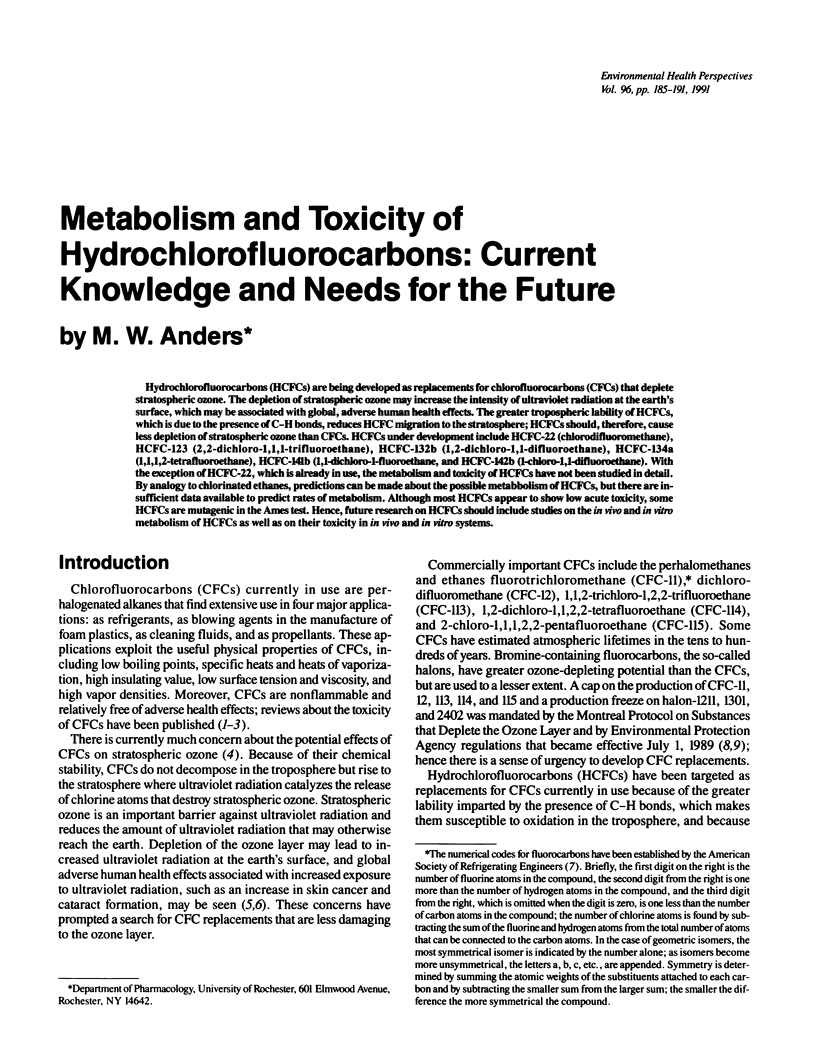
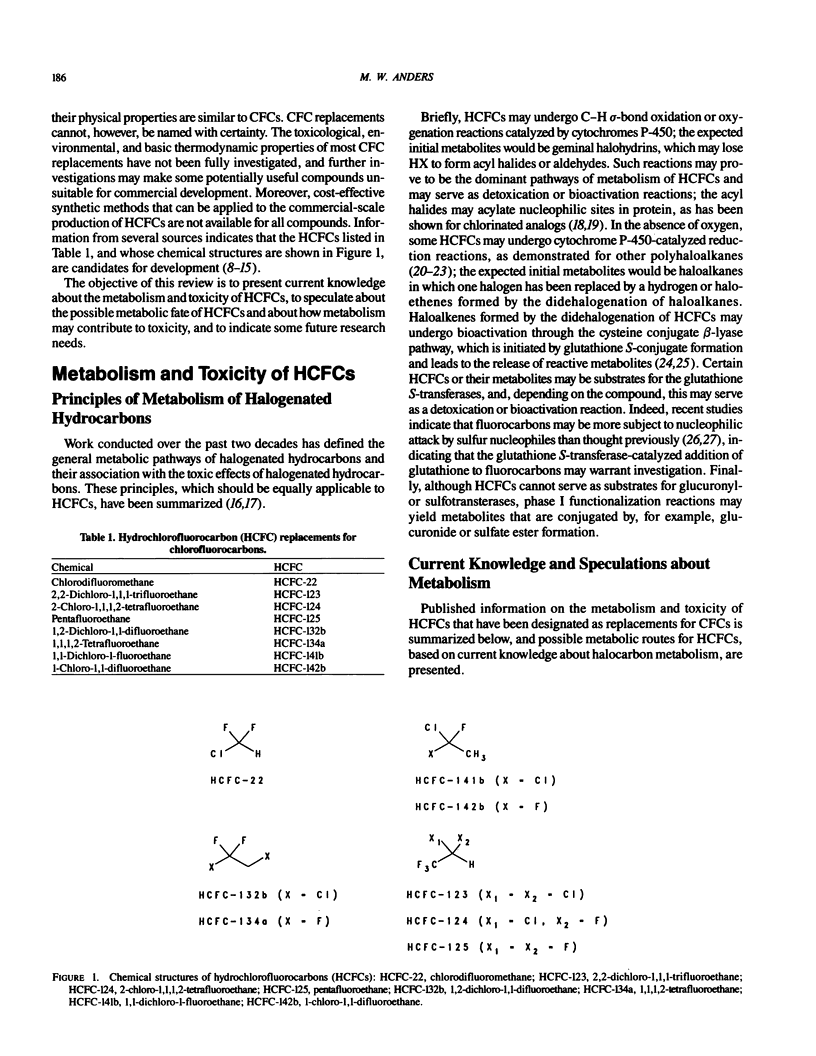
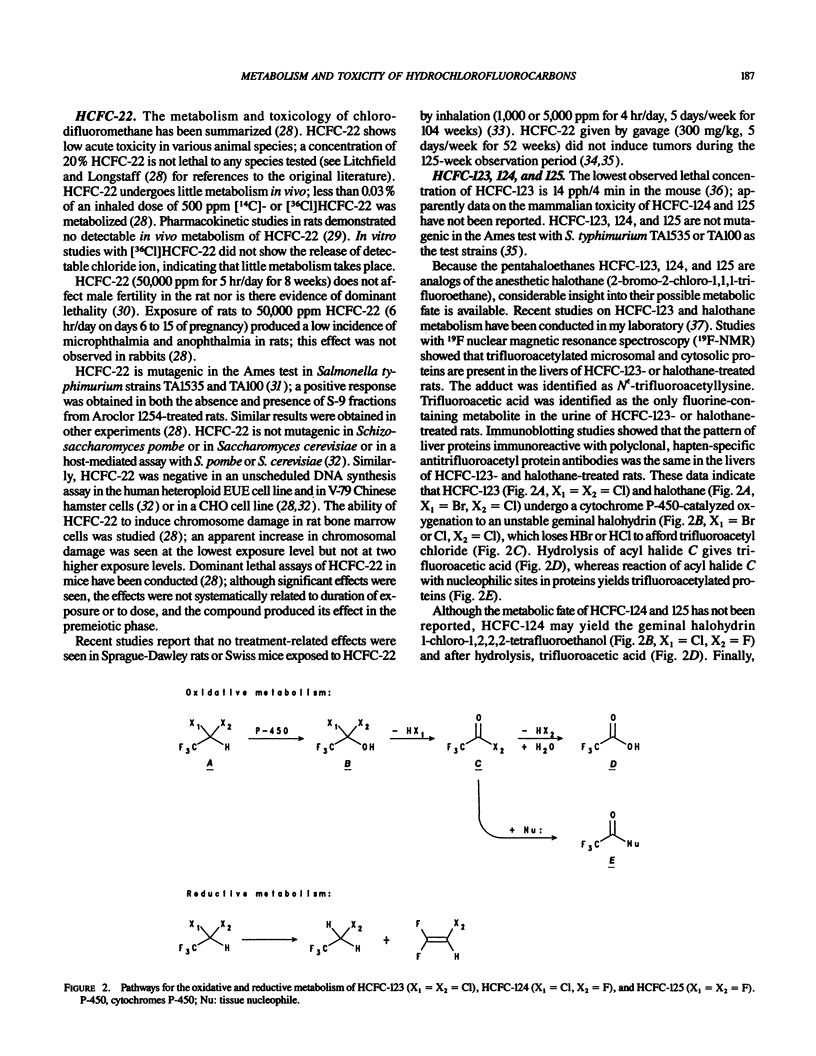
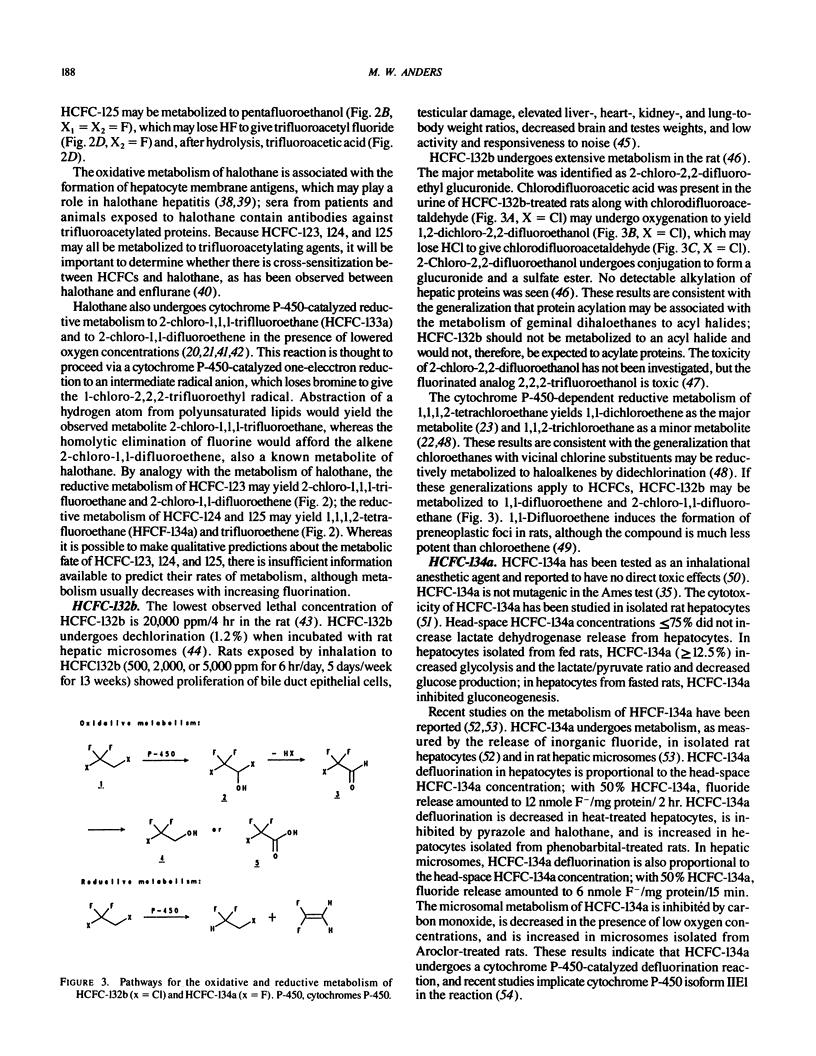
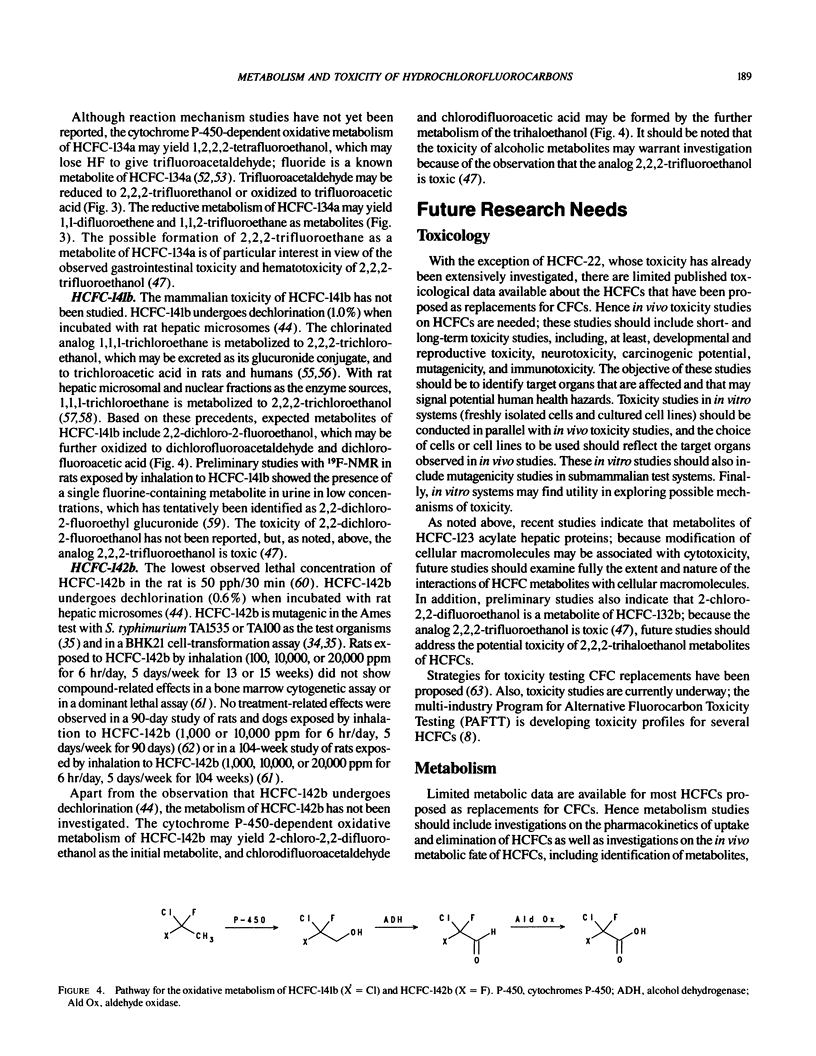
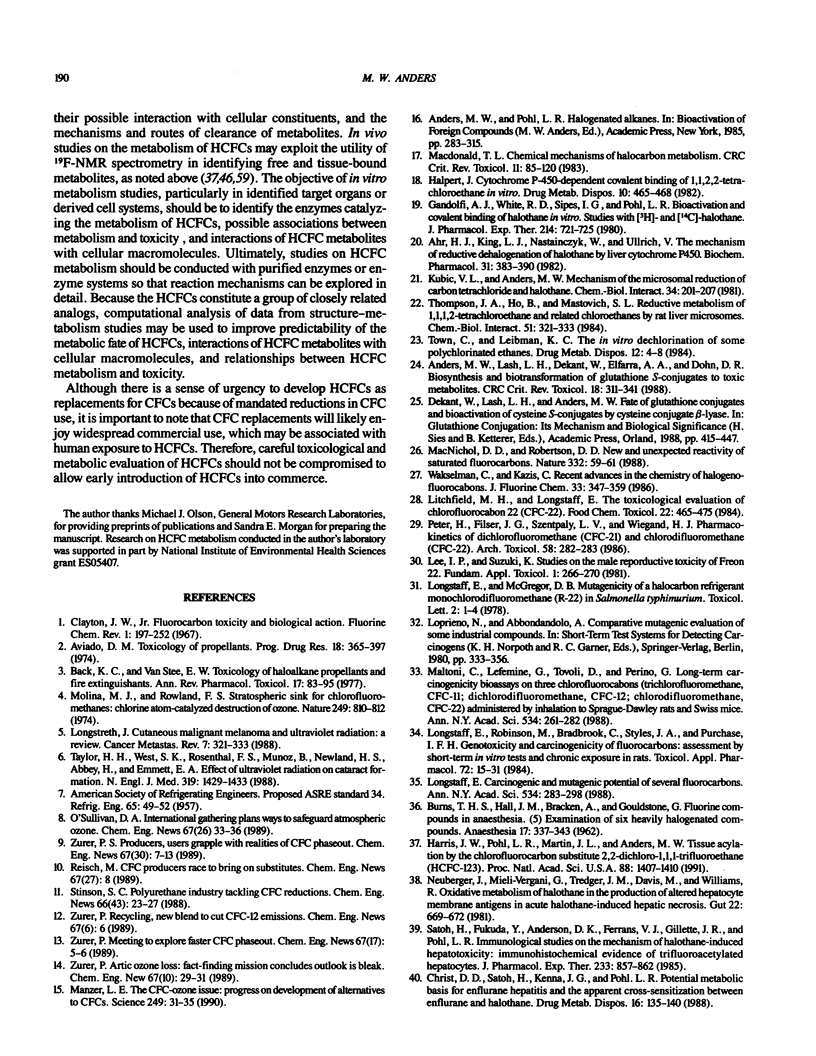
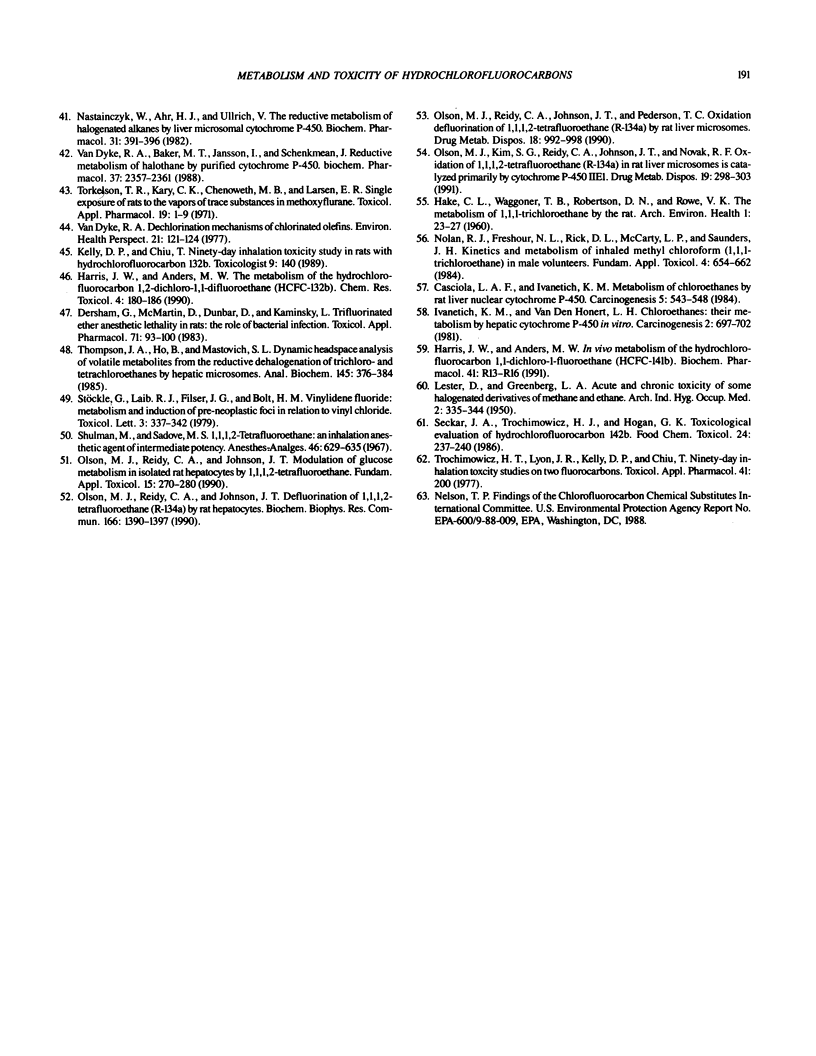
Selected References
These references are in PubMed. This may not be the complete list of references from this article.
- Ahr H. J., King L. J., Nastainczyk W., Ullrich V. The mechanism of reductive dehalogenation of halothane by liver cytochrome P450. Biochem Pharmacol. 1982 Feb 1;31(3):383–390. doi: 10.1016/0006-2952(82)90186-1. [DOI] [PubMed] [Google Scholar]
- Anders M. W., Lash L., Dekant W., Elfarra A. A., Dohn D. R. Biosynthesis and biotransformation of glutathione S-conjugates to toxic metabolites. Crit Rev Toxicol. 1988;18(4):311–341. doi: 10.3109/10408448809037470. [DOI] [PubMed] [Google Scholar]
- Aviado D. M. Toxicity of propellants. Prog Drug Res. 1974;18:365–397. doi: 10.1007/978-3-0348-7087-0_24. [DOI] [PubMed] [Google Scholar]
- BURNS T. H., HALL J. M., BRACKEN A., GOULDSTONE G. Fluorine compounds in anaesthesia. (5). Examination of six heavily halogenated aliphatic compounds. Anaesthesia. 1962 Jul;17:337–343. doi: 10.1111/j.1365-2044.1962.tb13474.x. [DOI] [PubMed] [Google Scholar]
- Back K. C., Van Stee W. Toxicology of haloalkane propellants and fire extinguishants. Annu Rev Pharmacol Toxicol. 1977;17:83–95. doi: 10.1146/annurev.pa.17.040177.000503. [DOI] [PubMed] [Google Scholar]
- Casciola L. A., Ivanetich K. M. Metabolism of chloroethanes by rat liver nuclear cytochrome P-450. Carcinogenesis. 1984 May;5(5):543–548. doi: 10.1093/carcin/5.5.543. [DOI] [PubMed] [Google Scholar]
- Christ D. D., Satoh H., Kenna J. G., Pohl L. R. Potential metabolic basis for enflurane hepatitis and the apparent cross-sensitization between enflurane and halothane. Drug Metab Dispos. 1988 Jan-Feb;16(1):135–140. [PubMed] [Google Scholar]
- Dersham G., McMartin D., Dunbar D., Kaminsky L. Trifluorinated ether anesthetic lethality in rats: the role of bacterial infection. Toxicol Appl Pharmacol. 1983 Oct;71(1):93–100. doi: 10.1016/0041-008x(83)90048-0. [DOI] [PubMed] [Google Scholar]
- Gandolfi A. J., White R. D., Sipes I. G., Pohl L. R. Bioactivation and covalent binding of halothane in vitro: studies with [3H]- and [14C]halothane. J Pharmacol Exp Ther. 1980 Sep;214(3):721–725. [PubMed] [Google Scholar]
- Halpert J. Cytochrome P-450-dependent covalent binding of 1,1,2,2-tetrachloroethane in vitro. Drug Metab Dispos. 1982 Sep-Oct;10(5):465–468. [PubMed] [Google Scholar]
- Harris J. W., Anders M. W. In vivo metabolism of the hydrochlorofluorocarbon 1,1-dichloro-1-fluoroethane (HCFC-141b). Biochem Pharmacol. 1991 May 1;41(9):R13–R16. doi: 10.1016/0006-2952(91)90096-n. [DOI] [PubMed] [Google Scholar]
- Harris J. W., Anders M. W. Metabolism of the hydrochlorofluorocarbon 1,2-dichloro-1,1-difluoroethane. Chem Res Toxicol. 1991 Mar-Apr;4(2):180–186. doi: 10.1021/tx00020a009. [DOI] [PubMed] [Google Scholar]
- Harris J. W., Pohl L. R., Martin J. L., Anders M. W. Tissue acylation by the chlorofluorocarbon substitute 2,2-dichloro-1,1,1-trifluoroethane. Proc Natl Acad Sci U S A. 1991 Feb 15;88(4):1407–1410. doi: 10.1073/pnas.88.4.1407. [DOI] [PMC free article] [PubMed] [Google Scholar]
- Ivanetich K. M., Van den Honert L. H. Chloroethanes : their metabolism by hepatic cytochrome P-450 in vitro. Carcinogenesis. 1981;2(8):697–702. doi: 10.1093/carcin/2.8.697. [DOI] [PubMed] [Google Scholar]
- LESTER D., GREENBERG L. A. Acute and chronic toxicity of some halogenated derivatives of methane and ethane. Arch Ind Hyg Occup Med. 1950 Sep;2(3):335–344. [PubMed] [Google Scholar]
- Lee I. P., Suzuki K. Studies on the male reproductive toxicity of Freon 22. Fundam Appl Toxicol. 1981 May-Jun;1(3):266–270. doi: 10.1016/s0272-0590(81)80126-1. [DOI] [PubMed] [Google Scholar]
- Litchfield M. H., Longstaff E. The toxicological evaluation of chlorofluorocarbon 22 (CFC 22). Food Chem Toxicol. 1984 Jun;22(6):465–475. doi: 10.1016/0278-6915(84)90331-4. [DOI] [PubMed] [Google Scholar]
- Longstaff E. Carcinogenic and mutagenic potential of several fluorocarbons. Ann N Y Acad Sci. 1988;534:283–298. doi: 10.1111/j.1749-6632.1988.tb30117.x. [DOI] [PubMed] [Google Scholar]
- Longstaff E., Robinson M., Bradbrook C., Styles J. A., Purchase I. F. Genotoxicity and carcinogenicity of fluorocarbons: assessment by short-term in vitro tests and chronic exposure in rats. Toxicol Appl Pharmacol. 1984 Jan;72(1):15–31. doi: 10.1016/0041-008x(84)90245-x. [DOI] [PubMed] [Google Scholar]
- Longstreth J. Cutaneous malignant melanoma and ultraviolet radiation: a review. Cancer Metastasis Rev. 1988 Dec;7(4):321–333. doi: 10.1007/BF00051373. [DOI] [PubMed] [Google Scholar]
- Macdonald T. L. Chemical mechanisms of halocarbon metabolism. Crit Rev Toxicol. 1983;11(2):85–120. doi: 10.3109/10408448309089849. [DOI] [PubMed] [Google Scholar]
- Maltoni C., Lefemine G., Tovoli D., Perino G. Long-term carcinogenicity bioassays on three chlorofluorocarbons (trichlorofluoromethane, FC11; dichlorodifluoromethane, FC12; chlorodifluoromethane, FC22) administered by inhalation to Sprague-Dawley rats and Swiss mice. Ann N Y Acad Sci. 1988;534:261–282. doi: 10.1111/j.1749-6632.1988.tb30116.x. [DOI] [PubMed] [Google Scholar]
- Manzer L. E. The CFC-Ozone Issue: Progress on the Development of Alternatives to CFCs. Science. 1990 Jul 6;249(4964):31–35. doi: 10.1126/science.249.4964.31. [DOI] [PubMed] [Google Scholar]
- Nastainczyk W., Ahr H. J., Ullrich V. The reductive metabolism of halogenated alkanes by liver microsomal cytochrome P450. Biochem Pharmacol. 1982 Feb 1;31(3):391–396. doi: 10.1016/0006-2952(82)90187-3. [DOI] [PubMed] [Google Scholar]
- Neuberger J., Mieli-Vergani G., Tredger J. M., Davis M., Williams R. Oxidative metabolism of halothane in the production of altered hepatocyte membrane antigens in acute halothane-induced hepatic necrosis. Gut. 1981 Aug;22(8):669–672. doi: 10.1136/gut.22.8.669. [DOI] [PMC free article] [PubMed] [Google Scholar]
- Nolan R. J., Freshour N. L., Rick D. L., McCarty L. P., Saunders J. H. Kinetics and metabolism of inhaled methyl chloroform (1,1,1-trichloroethane) in male volunteers. Fundam Appl Toxicol. 1984 Aug;4(4):654–662. doi: 10.1016/0272-0590(84)90057-5. [DOI] [PubMed] [Google Scholar]
- Olson M. J., Kim S. G., Reidy C. A., Johnson J. T., Novak R. F. Oxidation of 1,1,1,2-tetrafluoroethane in rat liver microsomes is catalyzed primarily by cytochrome P-450IIE1. Drug Metab Dispos. 1991 Mar-Apr;19(2):298–303. [PubMed] [Google Scholar]
- Olson M. J., Reidy C. A., Johnson J. T. Defluorination of 1,1,1,2-tetrafluoroethane (R-134a) by rat hepatocytes. Biochem Biophys Res Commun. 1990 Feb 14;166(3):1390–1397. doi: 10.1016/0006-291x(90)91021-j. [DOI] [PubMed] [Google Scholar]
- Olson M. J., Reidy C. A., Johnson J. T. Modulation of glucose metabolism in isolated rat hepatocytes by 1,1,1,2-tetrafluoroethane. Fundam Appl Toxicol. 1990 Aug;15(2):270–280. doi: 10.1016/0272-0590(90)90054-n. [DOI] [PubMed] [Google Scholar]
- Olson M. J., Reidy C. A., Johnson J. T., Pederson T. C. Oxidative defluorination of 1,1,1,2-tetrafluoroethane by rat liver microsomes. Drug Metab Dispos. 1990 Nov-Dec;18(6):992–998. [PubMed] [Google Scholar]
- Peter H., Filser J. G., von Szentpály L., Wiegand H. J. Different pharmacokinetics of dichlorofluoromethane (CFC 21) and chlorodifluoromethane (CFC 22). Arch Toxicol. 1986 Apr;58(4):282–283. doi: 10.1007/BF00297122. [DOI] [PubMed] [Google Scholar]
- Satoh H., Fukuda Y., Anderson D. K., Ferrans V. J., Gillette J. R., Pohl L. R. Immunological studies on the mechanism of halothane-induced hepatotoxicity: immunohistochemical evidence of trifluoroacetylated hepatocytes. J Pharmacol Exp Ther. 1985 Jun;233(3):857–862. [PubMed] [Google Scholar]
- Seckar J. A., Trochimowicz H. J., Hogan G. K. Toxicological evaluation of hydrochlorofluorocarbon 142b. Food Chem Toxicol. 1986 Mar;24(3):237–240. doi: 10.1016/0278-6915(86)90234-6. [DOI] [PubMed] [Google Scholar]
- Shulman M., Sadove M. S. 1,1,1,2-tetrafluoroethane: an inhalation anesthetic agent of intermediate potency. Anesth Analg. 1967 Sep-Oct;46(5):629–635. [PubMed] [Google Scholar]
- Taylor H. R., West S. K., Rosenthal F. S., Muñoz B., Newland H. S., Abbey H., Emmett E. A. Effect of ultraviolet radiation on cataract formation. N Engl J Med. 1988 Dec 1;319(22):1429–1433. doi: 10.1056/NEJM198812013192201. [DOI] [PubMed] [Google Scholar]
- Thompson J. A., Ho B., Mastovich S. L. Dynamic headspace analysis of volatile metabolites from the reductive dehalogenation of trichloro- and tetrachloroethanes by hepatic microsomes. Anal Biochem. 1985 Mar;145(2):376–384. doi: 10.1016/0003-2697(85)90377-x. [DOI] [PubMed] [Google Scholar]
- Thompson J. A., Ho B., Mastovich S. L. Reductive metabolism of 1,1,1,2-tetrachloroethane and related chloroethanes by rat liver microsomes. Chem Biol Interact. 1984 Oct;51(3):321–333. doi: 10.1016/0009-2797(84)90157-1. [DOI] [PubMed] [Google Scholar]
- Torkelson T. R., Kary C. D., Chenoweth M. B., Larsen E. R. Single exposure of rats to the vapors of trace substances in methoxyflurane. Toxicol Appl Pharmacol. 1971 May;19(1):1–9. doi: 10.1016/0041-008x(71)90183-9. [DOI] [PubMed] [Google Scholar]
- Van Dyke R. A., Baker M. T., Jansson I., Schenkman J. Reductive metabolism of halothane by purified cytochrome P-450. Biochem Pharmacol. 1988 Jun 15;37(12):2357–2361. doi: 10.1016/0006-2952(88)90361-9. [DOI] [PubMed] [Google Scholar]
- Van Dyke R. A. Dechloriation mechanisms of chlorinated olefins. Environ Health Perspect. 1977 Dec;21:121–124. doi: 10.1289/ehp.7721121. [DOI] [PMC free article] [PubMed] [Google Scholar]


